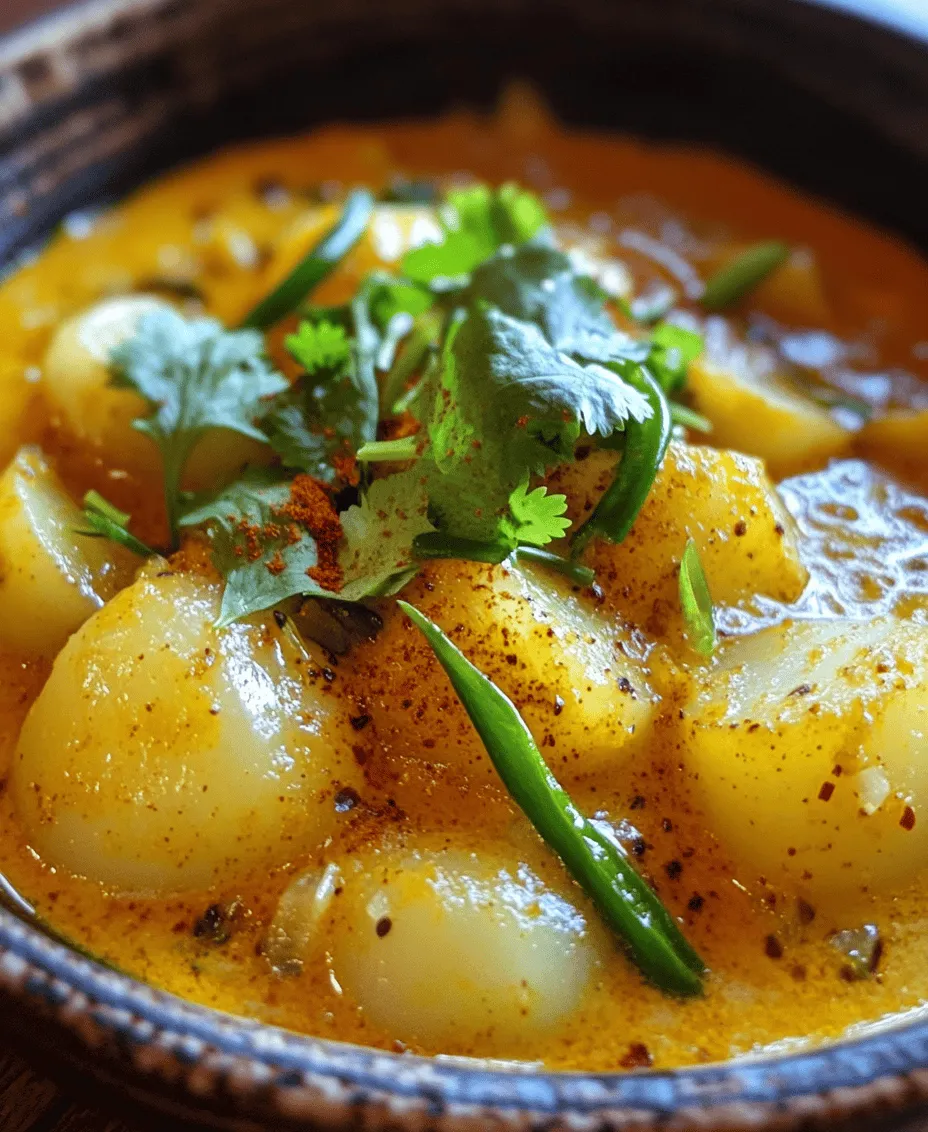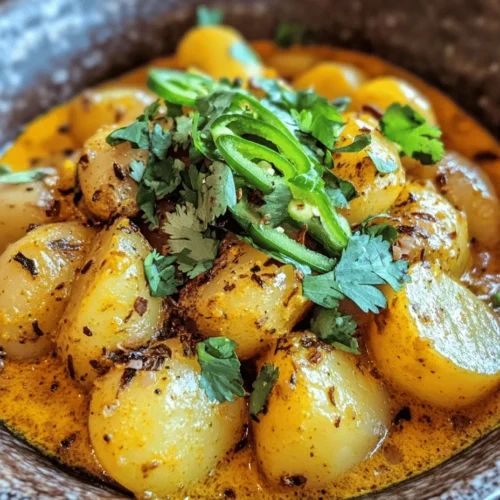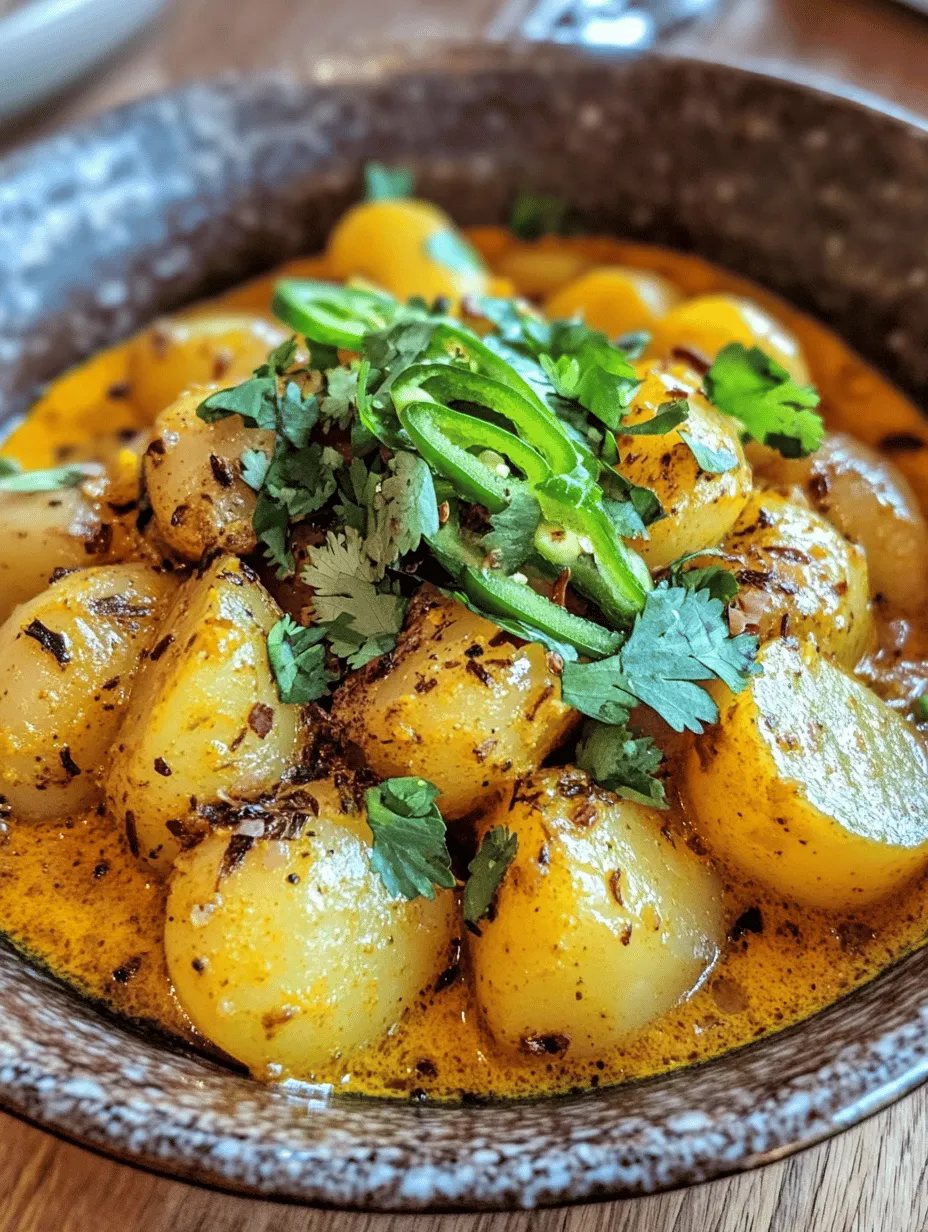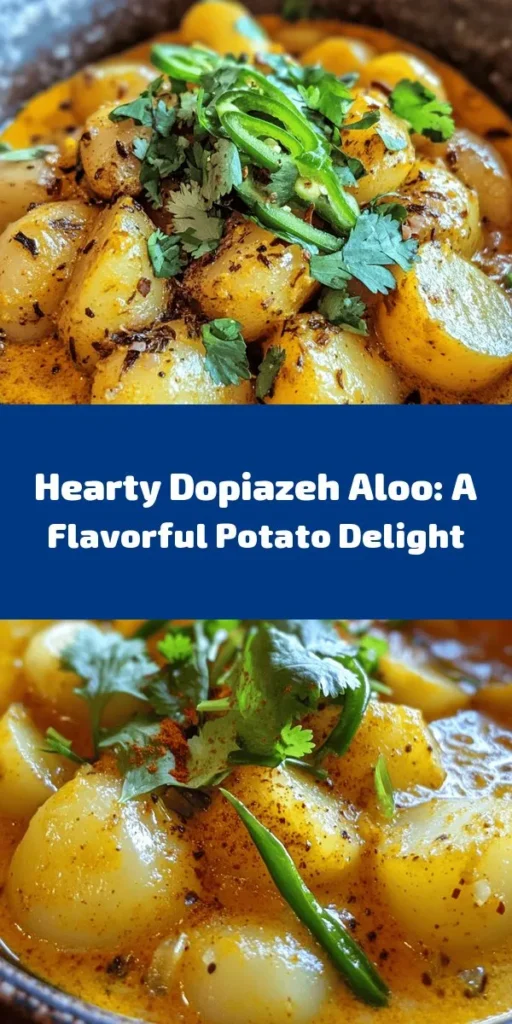Dopiazeh Aloo is a traditional Indian dish that beautifully marries the rich, earthy flavors of potatoes and the aromatic essence of onions. This vegetarian delight has been a staple in Indian households for generations, celebrated not just for its taste but also for its cultural significance. Originating from the northern regions of India, particularly Punjab and Uttar Pradesh, Dopiazeh Aloo is often prepared during family gatherings and festive occasions, making it a dish that resonates with warmth, comfort, and nostalgia.
Cultural Significance and Regional Variations
The term “Dopiazeh” has its roots in the Persian language, where “do” means two and “piaz” translates to onions. This etymology is a testament to the dish’s foundational ingredient—onions—used liberally to create a rich and layered flavor profile. While the base of the recipe remains constant, regional variations introduce unique twists that cater to local tastes. In some areas, for instance, Dopiazeh may include additional vegetables or proteins, while others may focus solely on the harmonious blend of potatoes and onions.
Dopiazeh Aloo is not just about taste; it embodies the heart of Indian cooking, where spices and cooking methods are passed down through generations. The dish showcases the art of layering flavors, often served with rice or Indian bread, making it a complete meal that nourishes both the body and soul. The comforting nature of Dopiazeh Aloo is especially appreciated during colder months, as it warms the heart and fills the home with an inviting aroma.
A Flavorful Vegetarian Option
For those seeking a hearty vegetarian meal, Dopiazeh Aloo is an ideal choice. It is not only comforting but also packed with flavor and nutrients, making it a wholesome dish for any occasion. The combination of the starchy potatoes and the flavorful onions creates a satisfying texture, while the spices elevate the dish to a culinary experience. Whether you are a seasoned cook or a kitchen novice, this recipe promises to deliver delightful results that will impress family and friends alike.
Understanding Dopiazeh Aloo
Definition and Etymology
As previously mentioned, the name Dopiazeh stems from the Persian words for “two onions.” This name reflects the dish’s key ingredient and its importance in the cooking process. In traditional recipes, onions are not only used as a base but are often featured prominently, sautéed to a golden brown to enhance their natural sweetness and deepen the overall flavor of the dish.
Connection to Traditional Cooking Methods and Spices Used
Dopiazeh Aloo is a prime example of traditional Indian cooking methods, which prioritize the use of fresh ingredients and a variety of spices. The process begins with sautéing onions until they achieve a rich caramelized color, which forms the foundation of the dish. The use of spices such as turmeric, cumin seeds, coriander powder, and garam masala not only adds depth to the flavor but also highlights the health benefits associated with these ingredients.
Nutritional Value
Dopiazeh Aloo is more than just a delicious dish; it is also a nutritious option for those looking to incorporate more vegetarian meals into their diet. The key ingredients—potatoes and onions—are naturally rich in vitamins and minerals. Potatoes provide a good source of carbohydrates, vitamin C, and potassium, while onions are known for their antioxidant properties and ability to support heart health.
The spices used in Dopiazeh Aloo are also noteworthy for their health benefits. Turmeric, for example, contains curcumin, a compound renowned for its anti-inflammatory properties. Cumin seeds are known to aid digestion and boost the immune system, while coriander powder adds a fresh, citrusy flavor that complements the dish beautifully.
Ingredients Breakdown
Overview of Key Ingredients
To create a delightful Dopiazeh Aloo, a few key ingredients are essential. The main components include:
– Potatoes: The star of the dish, they provide a comforting, starchy base that absorbs the flavors of the spices and onions.
– Onions: Their sweetness when caramelized adds depth and richness to the dish.
– Spices: A blend of spices enhances the flavor profile and contributes to the dish’s aromatic qualities.
Potatoes: Importance and Varieties Used in Indian Cooking
In Indian cuisine, potatoes are often referred to as “aloo” and are celebrated for their versatility. They can be prepared in countless ways, making them a beloved ingredient in many traditional dishes. When making Dopiazeh Aloo, it’s best to use starchy potatoes, such as Russets or Yukon Golds, as they hold their shape well during cooking and provide a fluffy texture.
Onions: The Role of Onions in Enhancing Flavor Profiles
Onions are a cornerstone of Indian cooking. They are used in various forms—raw, sautéed, caramelized, or pickled—each contributing a unique flavor to the dish. In Dopiazeh Aloo, the onions are sautéed until golden brown, a process that releases their natural sugars and creates a sweet, savory base for the potatoes.
Spices: Discuss Each Spice and Its Contribution to the Dish
The spices used in Dopiazeh Aloo not only enhance the flavor but also provide numerous health benefits. Here’s a closer look at the key spices:
– Turmeric: Known for its vibrant golden color and health benefits, turmeric adds warmth and earthiness to the dish. It also acts as a natural anti-inflammatory agent.
– Cumin Seeds: These seeds contribute a nutty, aromatic flavor. Cumin is known for its digestive properties and is often used to stimulate the appetite.
– Coriander Powder: With its mild, citrusy flavor, coriander powder balances the heat of the spices and adds complexity to the dish.
– Garam Masala: This spice blend adds warmth and depth, giving the dish an authentic Indian flavor profile.
Optional Ingredients for Personalization
While Dopiazeh Aloo is delicious as is, there are several optional ingredients you can incorporate to personalize the dish to your taste:
– Green Chilies: For those who enjoy a bit of heat, adding chopped green chilies can elevate the spice level and enhance the overall flavor.
– Fresh Cilantro: Chopped fresh cilantro makes for a bright, flavorful garnish that complements the dish beautifully and adds a pop of color.
Step-by-Step Instructions
Now that we have a solid understanding of the dish and its ingredients, let’s dive into the step-by-step instructions for preparing Dopiazeh Aloo.
Sautéing the Onions
The first step in making Dopiazeh Aloo is to sauté the onions. This is a crucial part of the cooking process, as the flavor of the dish largely depends on how well the onions are cooked.
1. Prepare the Onions: Start by peeling and slicing the onions thinly. The size of the slices can affect the cooking time; thinner slices will caramelize faster.
2. Heat the Oil: In a heavy-bottomed pan or skillet, heat a couple of tablespoons of oil over medium heat. Ghee (clarified butter) is a traditional choice and adds a rich flavor, but vegetable oil works well too.
3. Add the Onions: Once the oil is hot, add the sliced onions to the pan. Stir them occasionally to ensure even cooking.
4. Achieve Golden Brown Onions: The goal is to cook the onions until they are golden brown. This can take about 10-15 minutes. Be patient and avoid rushing the process, as this caramelization is key to developing a deep, rich flavor.
5. Incorporate Spices: Once the onions reach the desired color, it’s time to add the spices. Begin with the turmeric and cumin seeds, stirring them into the onions to release their aromatic oils. The heat should still be at medium to avoid burning the spices.
Looking Ahead
As we continue with the recipe, we will move on to the next steps, which involve adding the potatoes and allowing them to cook to perfection. With careful attention to detail and a touch of love, Dopiazeh Aloo will become a cherished addition to your culinary repertoire. Stay tuned for the continuation of this flavorful journey, where we will explore how to create this comforting dish that captures the essence of Indian home cooking.

Tips for Perfect Sautéing
When sautéing the onions for your Dopiazeh Aloo, the technique is crucial for developing the dish’s depth of flavor. Start by heating the oil in a heavy-bottomed pan over medium heat. The choice of oil can influence the final taste; mustard oil adds a distinctly sharp flavor, while ghee or vegetable oil can provide a more neutral backdrop.
To achieve that perfect golden-brown color, ensure that the pan is hot enough before adding the onions. If the oil shimmers, it’s a good sign. Once you add the chopped onions, keep them moving to ensure they sauté evenly, avoiding any burnt bits. Stir frequently for even cooking, and consider adding a pinch of salt early on to help draw out moisture from the onions. This technique not only enhances the sweetness of the onions but also aids in achieving that desirable caramelization.
Adding Spices
Spices are the heart of Dopiazeh Aloo and should be treated with care to maximize their flavors. Start by preparing your spices before you begin cooking to streamline the process. Common spices for this dish include cumin seeds, turmeric, coriander powder, and red chili powder.
Proper Technique for Releasing Spice Aromas
To truly release the essential oils and aromas of spices, it is best to add them at the right moment. Once your onions are golden brown and fragrant, create a small well in the center of the pan, then add your whole spices like cumin seeds. Allow them to sauté for about 30 seconds until they begin to sizzle. This method not only infuses the oil with flavor but also enhances the overall profile of the dish.
Timing for Adding Spices to Ensure Maximum Flavor
Timing is everything in cooking. After you’ve sautéed the onions and released the aromas of whole spices, it’s time to add your ground spices. This should be done just before you add the potatoes. Allow the ground spices to cook for a minute in the oil, stirring constantly. This ensures that they do not burn and that their essential flavors are fully released, enhancing the dish’s complexity.
Incorporating Potatoes
Once your spices are aromatic and well-blended with the onions, it’s time to add the potatoes. Cut your potatoes into uniform pieces to ensure they cook evenly. The size of the chunks can vary based on personal preference, but typically, one-inch pieces work best for this dish.
Methods to Ensure Even Cooking and Flavor Absorption
To further enhance the flavor absorption of your potatoes, consider parboiling them for a few minutes before adding them to the sautéed mixture. This pre-cooking method softens them slightly, allowing them to soak up the spices and flavors more effectively during the cooking process. Alternatively, you can toss the raw potatoes directly into the pan, ensuring they are coated with the sautéed onion and spices. Stir them well to allow for even distribution of flavors.
Simmering the Dish
Simmering is a critical step in creating the ideal texture and flavor profile for Dopiazeh Aloo. After incorporating the potatoes, add enough water (or vegetable broth for extra flavor) to cover the ingredients.
Ideal Cooking Times and Techniques for Perfect Texture
Bring the pot to a gentle boil, then reduce to a simmer. Cover the pot partially to allow some steam to escape, which helps in thickening the sauce as it cooks. The simmering time for Dopiazeh Aloo can range from 20 to 30 minutes, depending on the size of your potato chunks. Check for doneness by piercing a potato with a fork; it should be tender but not mushy.
Importance of Simmering in Developing Flavors
Simmering not only cooks the potatoes but also allows all the ingredients to meld together, creating a harmonious dish. This slow cooking process is vital for the spices to fully infuse their flavors into the potatoes, resulting in a rich and flavorful curry.
Finishing Touches
As your dish nears completion, it’s time to add the final touches that elevate Dopiazeh Aloo from good to exceptional.
Adding Garam Masala and Lemon Juice: Why It Matters
In the final minutes of cooking, sprinkle in a teaspoon of garam masala. This spice blend adds warmth and complexity to the dish. After removing the pot from heat, squeeze fresh lemon juice over the curry. The acidity brightens the flavors and balances the richness of the potatoes and spices, making each bite more vibrant.
Tips for Achieving the Desired Consistency
If you prefer a thicker sauce, you can mash a few potato pieces against the side of the pot, stirring them back into the curry. This method will naturally thicken the sauce without the need for additional thickeners, maintaining the integrity of the dish.
Garnishing and Serving Suggestions
Presentation plays a key role in enjoying your Dopiazeh Aloo.
Presentation Tips for an Appealing Dish
Serve your curry in a shallow bowl or plate, and garnish with freshly chopped cilantro or mint leaves for a splash of color and freshness. A dollop of yogurt on the side or a sprinkle of pomegranate seeds can add a delightful contrast to the vibrant colors of your curry.
Pairing Options: What to Serve with Dopiazeh Aloo
Dopiazeh Aloo pairs beautifully with various accompaniments. Consider serving it with fluffy basmati rice or warm naan bread to soak up the delicious sauce. A side of cooling cucumber raita can also complement the spices, providing a refreshing balance.
Cultural Context and Variations
Dopiazeh Aloo is not just a dish; it is a culinary representation of cultural heritage, showcasing the diversity and richness of Indian cuisine.
Regional Differences
Across India, Dopiazeh Aloo may vary significantly. In northern regions, you might find it prepared with more tomatoes and spices, while southern variations may include coconut or curry leaves, reflecting local tastes and ingredient availability. This adaptability is a hallmark of Indian cooking, allowing families to make the dish uniquely their own.
Comments on Authenticity Versus Modern Adaptations
While traditional recipes hold great value, modern adaptations have emerged, often introducing new spices or cooking techniques. Authenticity can be subjective; what matters most is how the dish resonates with those who prepare and enjoy it. Whether you stick to traditional methods or embrace innovative twists, Dopiazeh Aloo remains a comforting and satisfying dish.
Dopiazeh Aloo in Festivities and Daily Life
Dopiazeh Aloo often finds its place at family gatherings and celebrations.
Common Occasions for Serving This Dish
This dish is popular during festivals, family dinners, and potlucks, as it is both hearty and nourishing. Its vibrant flavors make it a favorite among vegetarian options, ensuring that everyone at the table can enjoy a fulfilling meal.
Role in Family Meals and Gatherings
In many households, preparing Dopiazeh Aloo is a communal activity, often involving family members gathering in the kitchen to chop, sauté, and create a dish that is as much about togetherness as it is about food. Sharing this dish during meals fosters a sense of connection, highlighting the importance of home-cooked meals in building bonds.
Conclusion
Dopiazeh Aloo is a delightful vegetarian dish that encapsulates the essence of Indian cuisine, delivering comforting flavors and a satisfying experience. Its rich history, diverse regional variations, and the joy it brings during shared meals make it a cherished recipe for many.
We encourage you to try this recipe at home, exploring the flavors and techniques that bring it to life. Engage with your loved ones in the cooking process, and savor the wonderful aromas and tastes that fill your kitchen. In a world increasingly leaning towards convenience, embracing the art of cooking and sharing meals can nurture our connections and enrich our culinary experiences. Enjoy the journey of creating Dopiazeh Aloo and discover the joy of home-cooked meals.



